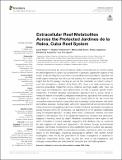Extracellular Reef Metabolites Across the Protected Jardines de la Reina, Cuba Reef System
Author(s)
Weber, Laura; Armenteros, Maickel; Kido Soule, Melissa; Longnecker, Krista; Kujawinski, Elizabeth B.; Apprill, Amy; ... Show more Show less
Downloadfmars-07-582161.pdf (4.100Mb)
Publisher with Creative Commons License
Publisher with Creative Commons License
Creative Commons Attribution
Terms of use
Metadata
Show full item recordAbstract
Coral reef ecosystems are incredibly diverse marine biomes that rely on nutrient cycling by microorganisms to sustain high productivity in generally oligotrophic regions of the ocean. Understanding the composition of extracellular reef metabolites in seawater, the small organic molecules that serve as the currency for microorganisms, may provide insight into benthic-pelagic coupling as well as the complexity of nutrient cycling in coral reef ecosystems. Jardines de la Reina (JR), Cuba is an ideal environment to examine extracellular metabolites across protected and high-quality reefs. Here, we used liquid chromatography mass spectrometry (LC-MS) to quantify specific known metabolites of interest (targeted metabolomics approach) and to survey trends in metabolite feature composition (untargeted metabolomics approach) from surface and reef depth (6 – 14 m) seawater overlying nine forereef sites in JR. We found that untargeted metabolite feature composition was surprisingly similar between reef depth and surface seawater, corresponding with other biogeochemical and physicochemical measurements and suggesting that environmental conditions were largely homogenous across forereefs within JR. Additionally, we quantified 32 of 53 detected metabolites using the targeted approach, including amino acids, nucleosides, vitamins, and other metabolic intermediates. Two of the quantified metabolites, riboflavin and xanthosine, displayed interesting trends by depth. Riboflavin concentrations were higher in reef depth compared to surface seawater, suggesting that riboflavin may be produced by reef organisms at depth and degraded in the surface through photochemical oxidation. Xanthosine concentrations were significantly higher in surface reef seawater. 5′-methylthioadenosine (MTA) concentrations increased significantly within the central region of the archipelago, displaying biogeographic patterns that warrant further investigation. Here we lay the groundwork for future investigations of variations in metabolite composition across reefs, sources and sinks of reef metabolites, and changes in metabolites over environmental, temporal, and reef health gradients.
Date issued
2020-12Department
Woods Hole Oceanographic Institution; Joint Program in Oceanography/Applied Ocean Science and Engineering; Joint Program in Biological Oceanography.Journal
Frontiers in Marine Science
Publisher
Frontiers Media SA
Citation
Weber, Laura et al. "Extracellular Reef Metabolites Across the Protected Jardines de la Reina, Cuba Reef System." Frontiers in Marine Science 7 (December 2020): 582161. © 2020 Weber et al.
Version: Final published version
ISSN
2296-7745